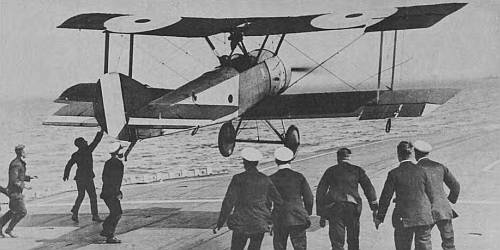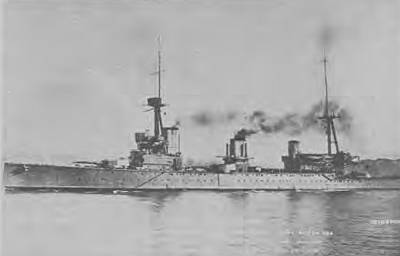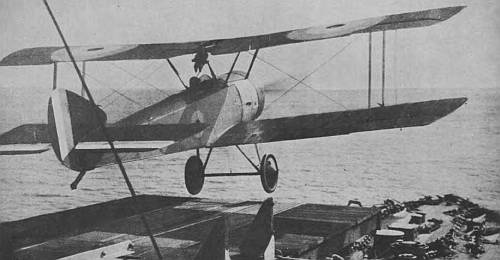- Author
- Issacs, Keith, AFC, ARAeS, Group Captain, RAAF (Retd)
- Subjects
- History - WW1, Naval Aviation
- Tags
-
- RAN Ships
- HMAS Melbourne I, HMAS Sydney I, HMAS Australia I
- Publication
- March 1974 edition of the Naval Historical Review (all rights reserved)

Additional evidence of the many misleading statements associated with the history of early Australian naval aviation exists in Rear-Admiral Sir Sidney Eardley- Wilmot’s Our Navy for a Thousand Years, which featured the aforementioned photograph with a caption stating that the aircraft is being launched from New Zealand instead of Australia. This error is perpetuated in the National Maritime Museum publication, Flying in the Royal Navy, 1914-64, by G.P.B. Naish, which has the same photograph and incorrect caption; as also does the otherwise authoritative History of Aircraft Carriers published in 1969 by Normal Polmar.

Other complications exist in the Strutter’s fuselage number which clearly reads 5644 and yet official records show that the numbers 5642 to 5648 were allocated to seven FE2a and 2b aircraft. The use of suspect or corrupt serial numbers was not uncommon and in Profile Publication, Number 13, The Sopwith Pup, J.M. Bruce reproduced a photograph of Pup 9497 carrying the incorrect number N.9497; an enlarged version of this photograph also appeared in the same author’s British Aeroplanes 1914-18. In all probability, therefore, the correct number for Australia’s 1½ Strutter was N.5644, a two-seat Type 9400 built by Mann, Eggerton and Company, which also operated later from New Zealand. (Of added interest is the fact that another 1½ Strutter, its wheels replaced by a skid undercarriage, took off on 20 March 1918 from wooden troughs on the deck of the carrier HMS Vindex. This aircraft was the single-seat Type 9700 Strutter, A.6911, piloted by Lieutenant W.G. Moore )
Notwithstanding the claim by Jose that a two-seater first took off from Australia on 8 March, H.A. Jones, also referring to Australia, stated that ‘on April 4 1918 Captain F.J. Fox, RAF, in a Sopwith, carrying an observer and full wireless equipment, made the first flight in a two-seater from a British warship.’ This latter claim has been reiterated by Bruce in British Aeroplanes 1914-18, Thetford in British Naval Aircraft Since 1912, and in Harleyford’s Marine Aircraft of the 1914-18 War. Presumably Jose was referring to the first two-seater launching with a pilot only, and Jones, and others, to the first fully loaded two-seater takeoff.
As a result of these achievements, ‘. . . it was decided to fit the forward turrets of all battle cruisers with extended platforms for two-seater aeroplanes, and the after turrets were to carry the single-seat fighters,’ stated H.A. Jones. Again this was not the case with the Indefatigable Class battle cruiser for their aircraft were carried on the amidships turrets; actually HMS Indefatigable was lost in the Battle of Jutland, and Australia and New Zealand were the only other warships of this type. Australia usually carried the Strutter to port on ‘P’ turret, and the Camel to starboard on ‘Q’ turret. In addition, Jane’s Fighting Ships, 1921, shows an aircraft being carried on the amidships turret of yet another battle cruiser, HMS Lion; as does Oscar Parkes’ British Battleships (1966) which featured the battle cruiser HMS Inflexible with an aircraft on a flight platform over the amidships turret. Parkes’ classic publication had a photograph of Australia carrying two aircraft, mistakenly captioned ‘The Australia in 1917 with aircraft ready to fly off.’ This, of course, should read 1918. The facts in the foregoing paragraphs are described in detail because of the numerous conflicting accounts, published over a period of 50 years, of Australia’s participation in this early episode of naval aviation history.

As 1918 progressed Strutter A.6968 and Camel N.6790 were carried on Australia, and later replaced by Strutter F.7562 and Camel N.6828. Pilots mentioned in Australia’s Ship’s Log include Captain Fox, who apparently spent most of 1918 on Australia, Flight Sub- Lieutenant L’Alouette, Lieutenant Paxman, and Captain Pritchard, who left on 3 August to join HMS Barham. Post-war photographs taken in December 1918 show Strutter F.7562 and a Camel aboard Australia at Rosyth. On 9 December 1918 the Australian Naval Board decided to purchase the aircraft attached to the Australian warships – the Strutter and Camel on Australia, and each of the Camels on HMA Ships Sydney and Melbourne. The Rear-Admiral Commanding then suggested that, unless it was planned to establish a local naval air service, it would be bad policy to retain the aircraft because of lack of facilities in Australia. Acting on this advice the Naval Board rescinded its decision, and the three warships landed their aircraft before returning to Australia in 1919.




